This article needs additional citations for verification .(August 2018) |




An oil-filter wrench is a tool for removing spin-on type oil filters.
This article needs additional citations for verification .(August 2018) |




An oil-filter wrench is a tool for removing spin-on type oil filters.
These filters are smooth, cylindrical canisters with knurling on the bottom that are difficult to grip, especially when they are oily.
One common type of wrench is shown on the right. The loop of chain is placed around the filter, and the bar is turned anticlockwise by hand until the chain wraps itself tightly around the filter. A socket wrench or adjustable spanner is then used to turn the hexagonal bar further in the same direction. This increases the tension in the chain, which bites into the soft metal casing of the oil filter which helps prevent slippage.
Another type uses a metal band that is attached at both ends to a handle. The looped band is placed around the filter and the handle is turned anticlockwise, which puts tension on the band, causing it to grip the filter.
A third common type of wrench utilizes a metal or plastic cup that is shaped much like a socket. The cup is placed on the end of the filter, which engages the knurling. A socket or wrench is then used to loosen the filter. Volkswagen Group and BMW cars require this type of wrench to remove their filters (or the lid of the filter housing, where a non-cartridge filter is used).
Finally, a "claw" type of wrench, manufactured by Sykes-Pickavant [1] and others, has three geared metal prongs and accommodates a (typically) 3⁄8" ratchet driver. As the driver is turned anticlockwise the gears make the prongs clench the filter body harder. This type is very effective on tight filters and can be used in more confined spaces than a strap or chain type.
K&N has designed their oil filters so that removal and installation can be done with a 3⁄4" or 19mm socket or wrench.
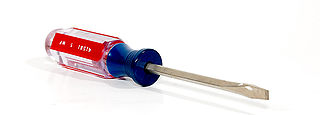
A screwdriver is a tool, manual or powered, used for turning screws.

A chainsaw is a portable gasoline-, electric-, or battery-powered saw that cuts with a set of teeth attached to a rotating chain driven along a guide bar. It is used in activities such as tree felling, limbing, bucking, pruning, cutting firebreaks in wildland fire suppression, and harvesting of firewood. Chainsaws with specially designed bar-and-chain combinations have been developed as tools for use in chainsaw art and chainsaw mills. Specialized chainsaws are used for cutting concrete during construction developments. Chainsaws are sometimes used for cutting ice; for example, ice sculpture and winter swimming in Finland.

A corkscrew is a tool for drawing corks from wine bottles and other household bottles that may be sealed with corks. In its traditional form, a corkscrew simply consists of a pointed metallic helix attached to a handle, which the user screws into the cork and pulls to extract it. Corkscrews are necessary because corks themselves, being small and smooth, are difficult to grip and remove, particularly when inserted fully into an inflexible glass bottle. More recent styles of corkscrew incorporate various systems of levers that further increase the amount of force that can be applied outwards upon the cork, making the extraction of difficult corks easier.

Knurling is a manufacturing process, typically conducted on a lathe, whereby a pattern of straight, angled or crossed lines is rolled into the material. Knurling can also refer to material that has a knurled pattern.

A socket wrench is a type of spanner that uses a closed socket format, rather than a typical open wrench/spanner to turn a fastener, typically in the form of a nut or bolt.

Hydraulic machines use liquid fluid power to perform work. Heavy construction vehicles are a common example. In this type of machine, hydraulic fluid is pumped to various hydraulic motors and hydraulic cylinders throughout the machine and becomes pressurized according to the resistance present. The fluid is controlled directly or automatically by control valves and distributed through hoses, tubes, or pipes.

In American English, a set screw is a screw that is used to secure an object, by pressure and/or friction, within or against another object, such as fixing a pulley or gear to a shaft. A set screw is normally used without a nut, being screwed instead in a threaded hole drilled in only one of the two objects to be secured. A set screw is often headless and threaded along its entire length, so that it will sit entirely inside that hole; in which case it may be called a grub screw or blind screw.
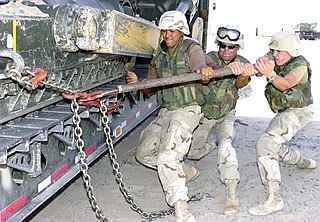
A cheater bar, snipe, or cheater pipe is an improvised breaker bar made from a length of pipe and a wrench (spanner).

Wire rope is several strands of metal wire twisted into a helix forming a composite rope, in a pattern known as laid rope. Larger diameter wire rope consists of multiple strands of such laid rope in a pattern known as cable laid.

A cocktail strainer is a metal bar accessory used to remove ice from a mixed drink as it is poured into the serving glass. A type of sieve, the strainer is placed over the mouth of the glass or shaker in which the beverage was prepared; small holes in the device allow only liquids to pass as the beverage is poured.
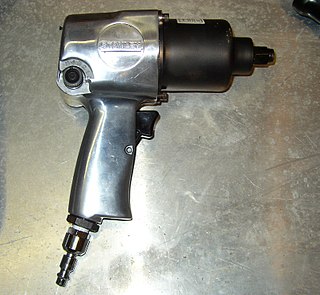
An impact wrench is a socket wrench power tool designed to deliver high torque output with minimal exertion by the user, by storing energy in a rotating mass, then delivering it suddenly to the output shaft. It was invented by Robert H. Pott of Evansville, Indiana.
A breaker bar is a long non-ratcheting bar that is used with socket wrench-style sockets. They are used to break loose very tight fasteners because their additional length allows the same amount of force to generate significantly more torque than a standard length socket wrench. Their use prevents damage to the ratcheting mechanism of a socket wrench. Often, after the first half turn, the fastener is loose enough to be turned with a socket wrench.

Tie down hardware is used to turn webbing into a tie down strap. There are various categories of tie down strap hardware that allow for the creation of a virtually unlimited number of different types of tie down straps. These pieces of hardware fall into several categories including fasteners, end fittings, and buckles.
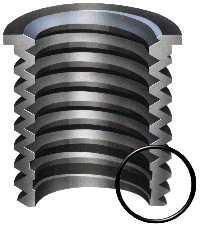
A threaded insert, also known as a threaded bushing, is a fastener element that is inserted into an object to add a threaded hole. They may be used to repair a stripped threaded hole, provide a durable threaded hole in a soft material, place a thread on a material too thin to accept it, mold or cast threads into a work piece thereby eliminating a machining operation, or simplify changeover from unified to metric threads or vice versa.
Motorcycle components and systems for a motorcycle are engineered, manufactured, and assembled in order to produce motorcycle models with the desired performance, aesthetics, and cost. The key components of modern motorcycles are presented below.
A strap wrench is any of various types of wrench that grip an object via a strap or chain being pulled in tension around it until it firmly grips. High static friction keeps it from slipping.
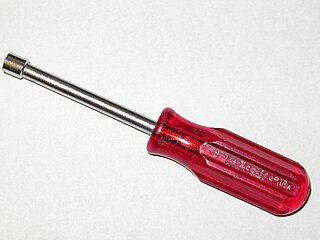
A nut driver is a tool for tightening or loosening nuts and bolts. It essentially consists of a socket attached to a shaft and cylindrical handle and is similar in appearance and use to a screwdriver. They generally have a hollow shaft to accommodate a shank onto which a nut is threaded. They are typically used for lower torque applications than wrenches or ratchets and are frequently used in the appliance repair and electronics industries.
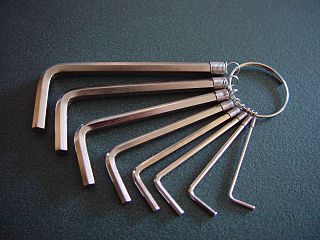
A hex key is a simple driver for bolts or screws that have heads with internal hexagonal recesses (sockets).